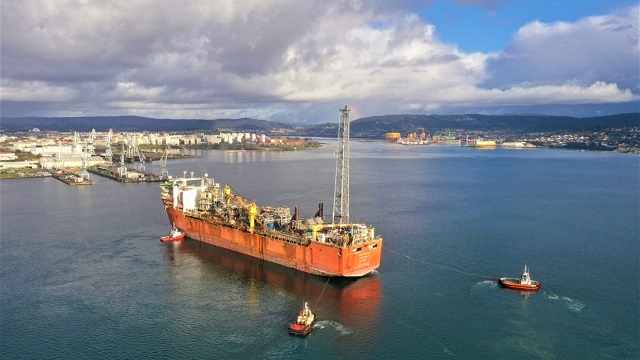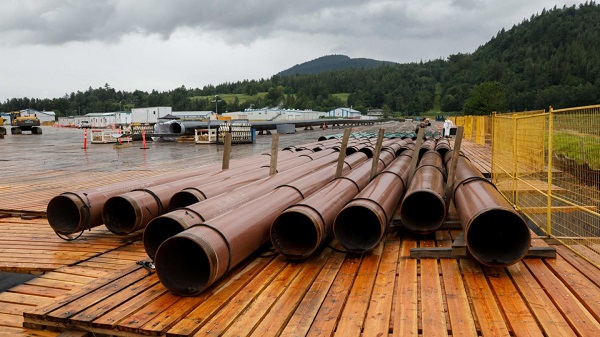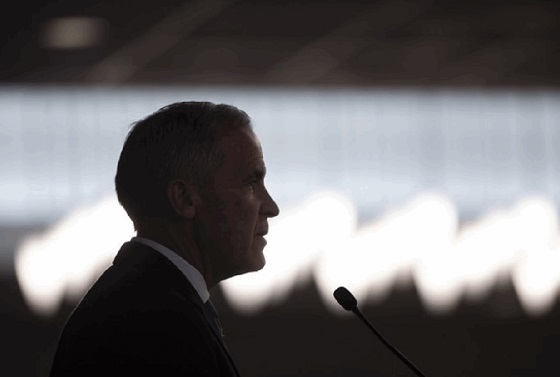Canadian Energy Centre
Terra Nova back producing oil, benefits to flow for Atlantic Canada communities and world energy security

The Terra Nova floating production, storage and offloading (FPSO) vessel. Photo courtesy Suncor Energy
From the Canadian Energy Centre
By Will Gibson
‘You should see it start to make a real impact on the market by 2025’
The Terra Nova offshore oil project sits about 350 kilometres southeast of St. John’s in the deep blue waters of the Atlantic.
And even though St. John’s Mayor Danny Breen can’t see the field and its massive floating, production, storage and offloading (FPSO) vessel from his office at city hall, he’s pleased it’s back to producing oil.
“There’s lots of numbers you could use to demonstrate Terra Nova’s contribution to our province and community, from the royalties and taxes it generates for governments or the jobs and contracts it provides to people and businesses,” says Breen.
“But it’s important for our psyche to see the FPSO back in production. To see it come back after some delays is great news for the province and the offshore industry.”
Suncor Energy CEO Rich Kruger announced in late November that Terra Nova’s FPSO vessel had restarted production after undergoing an extensive makeover in Spain to improve reliability and extend its life.
The massive vessel — standing 18 stories high and three football fields long — first started operating in 2002 and has produced more than 425 million barrels of oil, or enough to meet world oil demand at current levels for just over four years.
While the FPSO was in Spain, additional subsea work took place in the middle of the Atlantic to extend the Terra Nova field’s life, including replacing two million kilograms of mooring chain that anchors the ship to the underwater drilling system.
The project is forecast to extend the life of the Terra Nova project by 10 years and produce an additional 70 million barrels.
Phil Skolnick, Eight Capital’s managing director of research, sees Europe and Asia as potential destinations for those barrels when the project ramps up to full production.
Asian oil demand is rising, and Europe is now taking higher volumes of oil imports from countries other than Russia, its primary supplier before the start of the war in Ukraine.
“You should see it start to make a real impact on the market by 2025, when Terra Nova is expected to get back to producing 180,000 barrels per day,” he says.
“It will have a big impact for the Newfoundland economy.”
Even when the FPSO was in drydock in Spain, Terra Nova continued to provide benefits to the community at home.
In the third quarter of 2023, the latest period available, the project reported it spent $173.8 million in operational and capital expenditures.
This included $52.2 million in procuring goods and services, with 62 per cent spent with suppliers in the province and 94 per cent with Canadian vendors.
Terra Nova provides 710 direct jobs with 90 per cent of its workforce residing in Newfoundland and Labrador. The project is a partnership operated by Suncor, which holds a 48 per cent stake. The other partners are Cenovus Energy (34 per cent) and Murphy Oil (18 per cent).
While wind, hydrogen and other energy projects have been proposed in Newfoundland and Labrador, Breen sees the offshore oil industry as a crucial part of the province’s economy now and in the future.
He believes Terra Nova and the other three producing oil fields in the province — Hibernia, Hebron and White Rose — will assume added importance for the local economy and global energy security.
“Oil is going to be around for a long time, even if demand decreases, because it is an essential part of so many products we use today. And that’s important for us because the offshore industry supports many families across Newfoundland and Labrador today,” Breen says.
“The industry has been under a lot of scrutiny and has faced a lot of challenges, particularly in the approval for new projects. Keeping the production from approved supplies is going to be vital. That’s why it’s good to see the investment in Terra Nova and the return to production. That bodes well for the future.”
Alberta
Alberta’s huge oil sands reserves dwarf U.S. shale

From the Canadian Energy Centre
By Will Gibson
Oil sands could maintain current production rates for more than 140 years
Investor interest in Canadian oil producers, primarily in the Alberta oil sands, has picked up, and not only because of expanded export capacity from the Trans Mountain pipeline.
Enverus Intelligence Research says the real draw — and a major factor behind oil sands equities outperforming U.S. peers by about 40 per cent since January 2024 — is the resource Trans Mountain helps unlock.
Alberta’s oil sands contain 167 billion barrels of reserves, nearly four times the volume in the United States.
Today’s oil sands operators hold more than twice the available high-quality resources compared to U.S. shale producers, Enverus reports.
“It’s a huge number — 167 billion barrels — when Alberta only produces about three million barrels a day right now,” said Mike Verney, executive vice-president at McDaniel & Associates, which earlier this year updated the province’s oil and gas reserves on behalf of the Alberta Energy Regulator.
Already fourth in the world, the assessment found Alberta’s oil reserves increased by seven billion barrels.
Verney said the rise in reserves despite record production is in part a result of improved processes and technology.
“Oil sands companies can produce for decades at the same economic threshold as they do today. That’s a great place to be,” said Michael Berger, a senior analyst with Enverus.
BMO Capital Markets estimates that Alberta’s oil sands reserves could maintain current production rates for more than 140 years.
The long-term picture looks different south of the border.
The U.S. Energy Information Administration projects that American production will peak before 2030 and enter a long period of decline.
Having a lasting stable source of supply is important as world oil demand is expected to remain strong for decades to come.
This is particularly true in Asia, the target market for oil exports off Canada’s West Coast.
The International Energy Agency (IEA) projects oil demand in the Asia-Pacific region will go from 35 million barrels per day in 2024 to 41 million barrels per day in 2050.
The growing appeal of Alberta oil in Asian markets shows up not only in expanded Trans Mountain shipments, but also in Canadian crude being “re-exported” from U.S. Gulf Coast terminals.
According to RBN Energy, Asian buyers – primarily in China – are now the main non-U.S. buyers from Trans Mountain, while India dominates purchases of re-exports from the U.S. Gulf Coast. .
BMO said the oil sands offers advantages both in steady supply and lower overall environmental impacts.
“Not only is the resulting stability ideally suited to backfill anticipated declines in world oil supply, but the long-term physical footprint may also be meaningfully lower given large-scale concentrated emissions, high water recycling rates and low well declines,” BMO analysts said.
Alberta
The case for expanding Canada’s energy exports

From the Canadian Energy Centre
For Canada, the path to a stronger economy — and stronger global influence — runs through energy.
That’s the view of David Detomasi, a professor at the Smith School of Business at Queen’s University.
Detomasi, author of Profits and Power: Navigating the Politics and Geopolitics of Oil, argues that there is a moral case for developing Canada’s energy, both for Canadians and the world.
CEC: What does being an energy superpower mean to you?
DD: It means Canada is strong enough to affect the system as a whole by its choices.
There is something really valuable about Canada’s — and Alberta’s — way of producing carbon energy that goes beyond just the monetary rewards.
CEC: You talk about the moral case for developing Canada’s energy. What do you mean?
DD: I think the default assumption in public rhetoric is that the environmental movement is the only voice speaking for the moral betterment of the world. That needs to be challenged.
That public rhetoric is that the act of cultivating a powerful, effective economic engine is somehow wrong or bad, and that efforts to create wealth are somehow morally tainted.
I think that’s dead wrong. Economic growth is morally good, and we should foster it.
Economic growth generates money, and you can’t do anything you want to do in social expenditures without that engine.
Economic growth is critical to doing all the other things we want to do as Canadians, like having a publicly funded health care system or providing transfer payments to less well-off provinces.
Over the last 10 years, many people in Canada came to equate moral leadership with getting off of oil and gas as quickly as possible. I think that is a mistake, and far too narrow.
Instead, I think moral leadership means you play that game, you play it well, and you do it in our interest, in the Canadian way.
We need a solid base of economic prosperity in this country first, and then we can help others.
CEC: Why is it important to expand Canada’s energy trade?
DD: Canada is, and has always been, a trading nation, because we’ve got a lot of geography and not that many people.
If we don’t trade what we have with the outside world, we aren’t going to be able to develop economically, because we don’t have the internal size and capacity.
Historically, most of that trade has been with the United States. Geography and history mean it will always be our primary trade partner.
But the United States clearly can be an unreliable partner. Free and open trade matters more to Canada than it does to the U.S. Indeed, a big chunk of the American people is skeptical of participating in a global trading system.
As the United States perhaps withdraws from the international trading and investment system, there’s room for Canada to reinforce it in places where we can use our resource advantages to build new, stronger relationships.
One of these is Europe, which still imports a lot of gas. We can also build positive relationships with the enormous emerging markets of China and India, both of whom want and will need enormous supplies of energy for many decades.
I would like to be able to offer partners the alternative option of buying Canadian energy so that they are less reliant on, say, Iranian or Russian energy.
Canada can also maybe eventually help the two billion people in the world currently without energy access.
CEC: What benefits could Canadians gain by becoming an energy superpower?
DD: The first and primary responsibility of our federal government is to look after Canada. At the end of the day, the goal is to improve Canada’s welfare and enhance its sovereignty.
More carbon energy development helps Canada. We have massive debt, an investment crisis and productivity problems that we’ve been talking about forever. Economic and job growth are weak.
Solving these will require profitable and productive industries. We don’t have so many economic strengths in this country that we can voluntarily ignore or constrain one of our biggest industries.
The economic benefits pay for things that make you stronger as a country.
They make you more resilient on the social welfare front and make increasing defence expenditures, which we sorely need, more affordable. It allows us to manage the debt that we’re running up, and supports deals for Canada’s Indigenous peoples.
CEC: Are there specific projects that you advocate for to make Canada an energy superpower?
DD: Canada’s energy needs egress, and getting it out to places other than the United States. That means more transport and port facilities to Canada’s coasts.
We also need domestic energy transport networks. People don’t know this, but a big chunk of Ontario’s oil supply runs through Michigan, posing a latent security risk to Ontario’s energy security.
We need to change the perception that pipelines are evil. There’s a spiderweb of them across the globe, and more are being built.
Building pipelines here, with Canadian technology and know-how, builds our competitiveness and enhances our sovereignty.
Economic growth enhances sovereignty and provides the resources to do other things. We should applaud and encourage it, and the carbon energy sector can lead the way.
-

 International20 hours ago
International20 hours agoOttawa is still dodging the China interference threat
-

 Business18 hours ago
Business18 hours agoThere’s No Bias at CBC News, You Say? Well, OK…
-

 Automotive17 hours ago
Automotive17 hours agoCanada’s EV gamble is starting to backfire
-

 International19 hours ago
International19 hours ago2025: The Year The Narrative Changed
-

 Fraser Institute2 days ago
Fraser Institute2 days agoCarney government sowing seeds for corruption in Ottawa
-

 Business1 day ago
Business1 day agoResidents in economically free states reap the rewards
-

 Alberta2 days ago
Alberta2 days agoAlberta Next Panel calls for less Ottawa—and it could pay off
-

 Daily Caller2 days ago
Daily Caller2 days agoWhile Western Nations Cling to Energy Transition, Pragmatic Nations Produce Energy and Wealth








